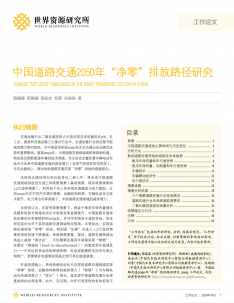Toward Net Zero Emissions in the Road Transport Sector in China
Road transport accounts for 70% of the transport sector’s emissions in China. Compared to the aviation and maritime sectors, the road transport sector is relatively easy to decarbonize and enjoys new opportunities such as vehicle electrification. There is momentum in China focusing on a “fossil fuel ban” as the main driving force to achieve net-zero emissions by 2050. This research aims to quantify the emission reduction potential of vehicle electrification and what role integrated measures such as mode shifts in passenger and freight transport, fuel economy standards, and urban planning can play in China’s efforts to attain net-zero CO2 emissions in the road transport sector.

The transport sector is second largest source of emissions in China, accounting for 9% of the country’s CO2 emissions. While CO2 emissions from the largest source, the power sector, have plateaued since 2017, the transport sector continues to grow steadily. According to a study carried out by the Energy Research Institute of the NDRC (2016), emissions from China’s transport sector will probably peak after 2035, five years later than China NDC’s target.
Road transport accounts for 70% of the transport sector’s emissions in China. Compared to the aviation and maritime sectors, which are traditionally difficult to decarbonize (Davis 2018), the road transport sector is relatively easy to decarbonize and enjoys new opportunities such as vehicle electrification. There is momentum in China focusing on a “fossil fuel ban” as the main driving force to achieve net-zero emissions by 2050.
This research aims to quantify the emission reduction potential of vehicle electrification and what role integrated measures such as mode shifts in passenger and freight transport, fuel economy standards, and urban planning can play in China’s efforts to attain net-zero CO2 emissions in the road transport sector.
This study adopts an ASIFG framework (Activity(A)-mode Share(S)-energy Intensity(I)-carbon intensity of Fuel(F)-Grid(G)), adapted from the existing ASIF model, to identify future driving forces of CO2 emissions in the road transport sector. Employing a bottom-up approach, the study projects trajectories in China’s road transport sector’s emissions under different policy scenarios, namely the ‘reference’, ‘current policy’, and ‘1.5 degree’ scenarios. The ‘reference’ scenario follows business as usual practices without any change in current policies. The ‘current policy’ scenario broadens the scope to include policies and targets announced by the government. The ‘1.5 degree’ scenario fast-tracks China’s road transport sector to meet the 1.5-degree goal. These three policy scenarios have varying degrees of low-carbon mode shares, electric vehicle market shares and electricity power mixes.
The study concludes that although findings of the existing studies bolster the result from the “reference’ scenario, the ‘current policy’ scenario, which better captures future policy pathways and emission trajectories, indicates a different possibility. As predicted in the ‘current policy’ scenario, thanks to the electrification of light-duty vehicles and the slowdown of car ownership growth, emissions from China’s road transport sector will likely peak in 2035, earlier than the existing studies.
Although a sector-wide early peak of CO2 emissions is possible, the transitions outlined in the ‘1.5 degree’ scenario are hard to deliver. After the emission peak — particularly in terms of ‘low lying fruit’ - are reaped, efforts to mitigate the road transport sector will have to reach higher. To deeply decarbonize the sector, China needs to not only seek aggressive measures such as fossil fuel bans on light-duty vehicles, but also tackle a harder-to-decarbonize mode —heavy-duty freight vehicles - by shifting road freight to waterways or railways, or banning fossil fuel vehicles. Furthermore, as vehicle electrification takes off, a higher proportion of renewable energy sources in the power sector will become necessary.
The research also reveals that there is no “silver bullet” for China’s road transport sector to meet the net-zero emission goal. While vehicle electrification offers more potentials for relatively larger emissions reduction, mode shift is equally important with similar decarbonization potentials.
Furthermore, the research shows different decarbonization measures have varying effects over time. In the near term, measures such as urban planning that lowers vehicle mileage are effective; yet, these mitigation effects will diminish as more vehicles become electrified. In the long run, measures such as decarbonizing the power sector will become increasingly important as mentioned before.
None of the emissions pathways outlined in this study is possible. Future actions taken by the Chinese government will be decisive in determining which pathway is followed, yet it is vital that it acts early to avoid the “lock-in effects” of transportation and power infrastructure.
Projects

Sustainable Mobility
Visit ProjectSustainable Mobility Project aims to contribute to the development of low-carbon transportation in China, and build a green, efficient, inclusive and resilient urban mobility system.
Part of Sustainable Cities
Low-carbon transport
Visit ProjectWe work with national and local partners to develop medium- and long-term transport decarbonization roadmaps, formulate near-term key emission-reduction solutions, and facilitate global knowledge sharing, to achieve the low-carbon transition of China’s transport sector while ensuring social equit
Part of Sustainable Cities
